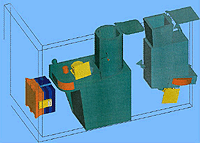
Optical, Spectroscopic, and Infrared Remote Imaging System (OSIRIS)
NSSDC ID: 2004-006A-01
Mission Name: Rosetta
Principal Investigator: Dr. Horst Uwe Keller
Description
The Optical, Spectroscopic, and Infrared Remote Imaging System (OSIRIS) is the primary imaging system on the Rosetta spacecraft. The primary scientific objectives of OSIRIS are to determine the volume, bulk density, rotational state, topography, surface features, color, and mineralogy of the nucleus; analyze short term variability, mass loss rate, outbursts, crustal diffusion processes, non-gravitational forces, and active regions on the nucleus; characterize possible landing sites; search for gravitationally bound material, particularly large orbiting particles; and study the dust and gas environment, including all sources of dust emission and their variation with time, optical and physical properties of the dust, dust partical size distribution, particle fragmentation, acceleration, condensation and optical depth effects close to the dust source, the near-surface flow field of dust and its temporal evolution, night-side activity and thermal inertia effects on emission, and the distribution of daughter and parent molecules to evaluate the usefulness of daughter molecules as tracers for parent species.
OSIRIS consists of two camera systems, the wide angle camera (WAC) designed to image large parts of the inner coma and the dust and gas emission directly above the surface of the nucleus, and the narrow angle camera (NAC), designed to study the nucleus at high resolution. A common electronics box is shared by both cameras. An infrared imaging system is included in the narrow angle camera. The wide-angle camera is a two-mirror off-axis F/5.6 system, the primary mirror is a convex oblate ellipsoid and the secondary is a concave oblate ellipsoid. A baffle and the off-axis design provide high straylight rejection. The image is focused onto a 2048 x 2048 CCD with 14 micron pixels. The CCD readout is passed to a 14-bit analog-to-digital converter and then to a data processing unit. The field-of-view is 12.1 by 12.1 degrees and the resolution is 100 microradians per pixel. The focal length is 140 mm and the framing rate is 3.5 s per image. The wavelength range of the camera is from 250 to 1000 nm, two filter wheels hold 14 filters covering appropriate gas emission lines.
The narrow angle camera is a three-mirror anastigmatic design using a concave hyperbolic primary, a convex parabolic secondary, and a concave spherical tertiary. The design, including a baffle, provides high straylight rejection. The image is focused onto a 2048 x 2048 CCD with 14 micron pixels. The CCD readout is passed to a 14-bit analog-to-digital converter and then to a data processing unit. The field-of-view is 2.35 by 2.35 degrees and the resolution is 20 microradians per pixel. The focal length is 700 mm and the framing rate is 3.5 s per image. The wavelength range of the narrow angle camera (not including the IR component) is from 250 to 1000 nm, two filter wheels hold 14 filters covering appropriate colors and mineral lines. A separate set of optics exists for the infrared system, light is channeled to these by a flip-feed mirror within the NAC. The incoming light passes through a filter wheel and enters a cold trap maintained at 130 K by passive cooling to a 0.5 square meter radiator. A filter wheel system similar to that used for the NAC and WAC will be employed, but adapted for cold temperatures and will carry filters for water and carbon dioxide among others. The image is captured by a 640 x 480 pixel cooled mercury cadmium telluride detector. Each pixel is 27 microns square with a resolution of 38.6 microradians per pixel. The wavelength range covered will be from 1 to 3.5 microns, possibly to 4.8 microns.
Facts in Brief
Mass: 23.1 kg
Power (avg): 32.4 W
Funding Agency
- European Space Agency (International)
Discipline
- Planetary Science: None assigned
Additional Information
Questions or comments about this experiment can be directed to: Dr. David R. Williams.
Personnel
| Name | Role | Original Affiliation | |
|---|---|---|---|
| Dr. Horst Uwe Keller | Principal Investigator | Max-Planck-Institut fur Aeronomie | keller@linmpi.mpg.de |
| Mr. Holger Sierks | Instrument Manager | Max-Planck-Institut fur Aeronomie | sierks@linmpi.mpg.de |
Selected References
Thomas, N., et al., OSIRIS-The Optical, Spectroscopic and Infrared Remote Imaging System for the Rosetta Orbiter, Adv. Space Res., 21, No. 11, 1505-1515, 1998.
![[Rosetta RPC]](http://nssdc.gsfc.nasa.gov/planetary/thumbnail/rosetta_osiris_vg.gif)
OSIRIS Home Page - Max-Planck-Institut fur Aeronomie, Germany

